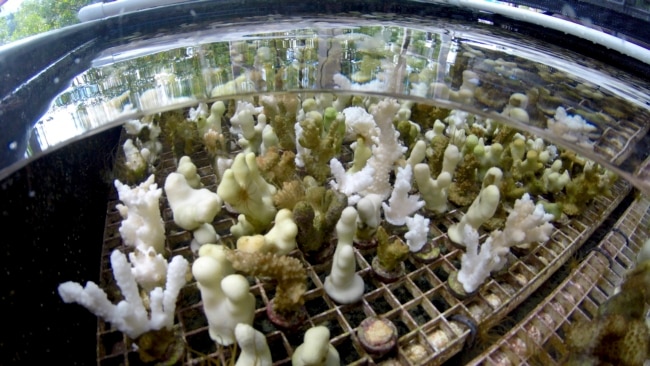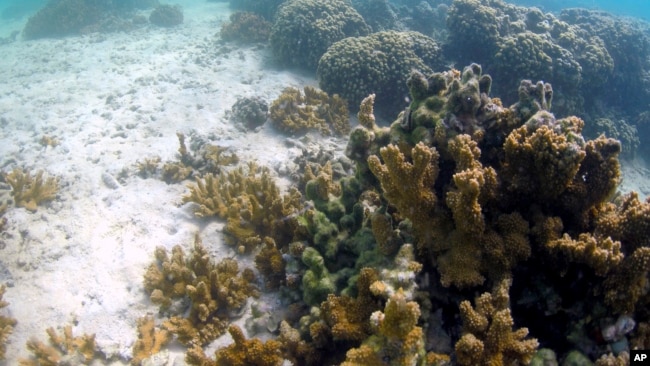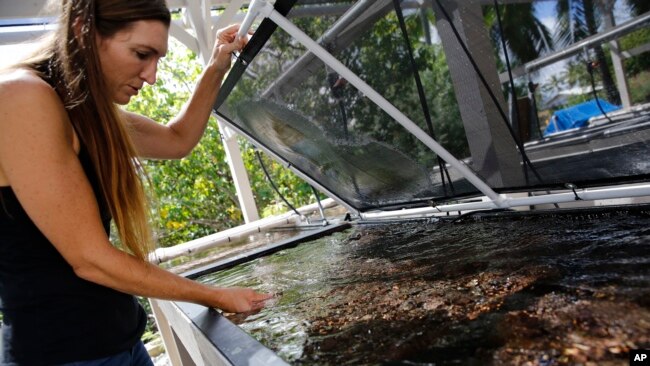珊瑚を救う方法
温暖化により海水温度が上昇して白化現象が起きた映像を見たことがあります。その悲惨な姿は今も心に深く残っています。
どうか救ってください。私たちができること、CO2排出量を抑えること!!
気候変動に耐えるサンゴを研究室で作成(和訳)
Scientists Create Corals in Lab to Better Resist Climate Change
December 27, 2021
サンゴというと、カラフルな魚が泳ぐ海の中の岩のような生命体を思い浮かべる人が多いのではないでしょうか。しかし、サンゴは何十万という小さな生物で構成されており、他の海の生物と同じように生活し、餌をとっているのです。
ハワイとオーストラリアの研究者たちは、過去5年間、研究室内でサンゴを工学的に改良し、気候変動の影響に耐えられるかどうかを調べてきました。
そして今、その成果が自然界でどのように機能するかを確認する時が来たといいます。
科学者たちは、人為的な気候変動によって海が温暖化し、海洋生物に害を及ぼしていると指摘しています。彼らが開発した耐熱性の高いサンゴが海中でうまく機能すれば、この方法は、苦しんで死んでいくサンゴ礁を救うのに役立つだろう、と彼らは言います。
研究チームは、自然界で強く健康なサンゴを作るための3つの方法をテストしました。
「サンゴ礁が将来にわたって生き残るための変化を起こすために、私たちは介入しなければなりません」とヒューズ氏は言います。
海水温が上昇すると、サンゴは栄養分を供給する藻類を放出し、色をつけます。これは白化現象と呼ばれ、サンゴが白くなってしまう現象です。この現象が起きると、サンゴはすぐに病気になり死んでしまいます。
しかし、科学者たちは何年も前から、同じサンゴ礁で他のサンゴが死んでも、白化せずに生き残っているサンゴを観察しています。現在では、この健康なサンゴを中心に、熱に対する抵抗力をさらに高めることを期待しています。そのサンゴを親にして、新しい種類のサンゴを作りました。
米国海洋大気庁とその他の研究機関による最近の研究では、白化現象について詳しく調査しています。その結果、白化現象は世界のサンゴ礁にとって現在最大の脅威であることが判明した。2009年から2018年の間に、世界のサンゴの約14パーセントが失われたことが判明しました。
ls.
Scientists Create Corals in Lab to Better Resist Climate Change
When corals are mentioned, many people think of rock-life forms in the sea filled with colorful fish. But corals are made up of hundreds of thousands of small organisms which live and feed like any other sea life.
For the past five years, researchers in Hawaii and Australia have been engineering corals inside a lab to see if they could better resist the effects of climate change.
They say it is now time to see how their creations perform in nature.
The scientists say climate change linked to human causes has led to warming oceans that can harm sea life. They say if the more heat-resistant corals they developed do well in the ocean, the method can be used to help save suffering and dying reefs.
The team tested three methods for making corals that would be strong and healthy in nature.
One was the method of selective breeding. This method involves scientists choosing parents with desirable characteristics for reproductive purposes. The goal is to produce babies with the same desirable characteristics.
A second method subjected the corals to increasing temperatures to condition them to be able to survive in warm ocean environments. The third involved making changes to the algae that provide corals with necessary nutrients.
The leader of the project, University of Hawaii researcher Kira Hughes, said all the methods proved successful in the lab.
She told The Associated Press that some scientists might worry that such methods go against the natural processes of nature. But with the planet continuing to warm more and more, she does not see any better options.
“We have to intervene in order to make a change for coral reefs to survive into the future,” Hughes said.
When ocean temperatures rise, corals release algae that supplies nutrients and gives them color. This causes them to turn white, a process called bleaching. When this happens, corals can quickly become sick and die.
But for years, scientists have been observing corals that have survived bleaching, even when others have died on the same reef. They are now centering on those healthy survivors and hoping to further increase their resistance to heat. Those corals were used as the parents for the newly created kinds.
A recent study from the National Oceanic and Atmospheric Administration and other research organizations took a close look at bleaching events. It found them to be the biggest current threat to the world's coral reefs. Scientists found that between 2009 and 2018, the world lost about 14 percent of its corals.
“Corals are threatened worldwide by a lot of stressors, but increasing temperatures are probably the most severe,” said Crawford Drury. He is the chief scientist at Hawaii’s Coral Resilience Lab.
Madeleine van Oppen is a research scientist with the Australian Institute of Marine Science. She told the AP there were concerns about whether the experiments could result in a loss of genetic diversity. And there were critics who said the scientists were “playing god” by making such changes to the reef.
“Well, you know, (humans) have already intervened with the reef for very long periods of time,” van Oppen said. “All we’re trying to do is to repair the damage.”
Rather than editing genes or creating anything unnatural, the researchers are just attempting to begin what could already happen in the ocean, van Oppen added. In this way, she said, the team can center on a small area to keep and “enhance” what is already there.
Words in This Story
coral – n. a hard, usually pink or white substance produced by a type of very small sea animal
reef – n. a chain of rocks or coral or a ridge of sand at or near the surface of water
characteristic – n. a typical quality that makes one person or thing different from others
algae – n. usually small plants that grow in or near water and do not have typical leaves of roots
stressor – n. something that causes stress (great worry or emotional difficulty
diversity – n. a situation in which many different kinds of things or people are included in something
enhance – v. to improve the quality, amount or strength of something



